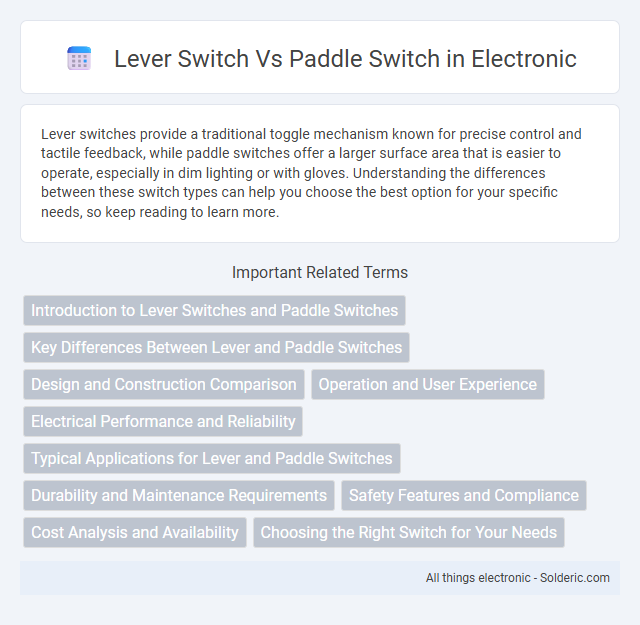Lever switches provide a traditional toggle mechanism known for precise control and tactile feedback, while paddle switches offer a larger surface area that is easier to operate, especially in dim lighting or with gloves. Understanding the differences between these switch types can help you choose the best option for your specific needs, so keep reading to learn more.
Comparison Table
| Feature | Lever Switch | Paddle Switch |
|---|---|---|
| Design | Small lever; toggled up/down or side | Wide, flat paddle; pushed for activation |
| Operation | Toggle action, physical movement of lever | Press action, ergonomic paddle press |
| Common Use | Light switches, industrial controls | Lighting controls, HVAC systems |
| Installation | Typically mounted on panels or walls | Usually surface-mounted or recessed |
| Durability | Moderate, depends on lever material | High, designed for frequent use |
| Ergonomics | Requires finger precision | Easy to activate, user-friendly |
| Cost | Generally low to moderate | Moderate, varies with features |
Introduction to Lever Switches and Paddle Switches
Lever switches and paddle switches are common types of mechanical switches used for controlling electrical circuits. Lever switches operate with a swinging arm that toggles between on and off positions, offering precise tactile feedback for industrial and consumer applications. Paddle switches feature a larger flat surface designed for easy activation by hand, making them ideal for environments requiring quick, intuitive control like power tools and heavy machinery.
Key Differences Between Lever and Paddle Switches
Lever switches feature a small, narrow toggle operated by pushing up or down, ideal for precise, minimal movement control, while paddle switches utilize a wider, flat actuator designed for easier activation with a larger surface area. Lever switches are commonly found in traditional lighting fixtures and equipment requiring fine tactile feedback, whereas paddle switches are preferred in modern household lighting due to their ergonomic design and accessibility. The key differences lie in their size, ease of operation, and typical applications, with paddle switches offering enhanced usability in environments prioritizing user comfort and accessibility.
Design and Construction Comparison
Lever switches feature a small, narrow actuator that moves up and down, ideal for precise control in compact spaces. Paddle switches offer a larger, flat surface that is easier to operate with a simple push, enhancing accessibility and usability in high-traffic areas. Your choice depends on the desired tactile feedback and installation environment, with lever switches excelling in discreet designs and paddle switches providing ergonomic advantages.
Operation and User Experience
Lever switches provide a tactile, linear motion that many users find intuitive and precise, allowing for clear on/off feedback and easy control in various applications. Paddle switches feature a broader surface area that facilitates quicker activation and better ergonomics, especially in environments where users may wear gloves or require rapid switching. Both types offer distinct user experiences, with lever switches excelling in detailed control and paddle switches optimizing speed and accessibility.
Electrical Performance and Reliability
Lever switches provide consistent electrical performance with stable current flow and low contact resistance, making them ideal for precise control applications. Paddle switches offer enhanced reliability due to their robust mechanical design, reducing the risk of contact wear and electrical failure over extended use. Your choice should consider the required electrical load and durability to ensure optimal switch performance in your specific application.
Typical Applications for Lever and Paddle Switches
Lever switches are commonly used in industrial machinery for precise mechanical control and limit detection, such as conveyor systems and safety interlocks. Paddle switches are frequently employed in fluid-level sensing applications within tanks and reservoirs due to their ability to detect flow or liquid presence. Both switch types offer reliable performance in automation, but lever switches excel in mechanical operations while paddle switches are preferred for liquid level monitoring.
Durability and Maintenance Requirements
Lever switches generally offer higher durability due to their robust mechanical design and resistance to wear from frequent use, making them ideal for heavy-duty applications. Paddle switches, while providing ergonomic benefits and sleek design, may require more frequent maintenance to ensure reliable operation, especially in high-traffic environments. Choosing between the two depends on your specific needs for longevity and the level of upkeep you are willing to manage.
Safety Features and Compliance
Lever switches and paddle switches both offer robust safety features, but lever switches often include enhanced protective covers and tactile feedback that reduce accidental activations. Paddle switches frequently comply with industry standards like UL and IEC due to their ergonomic design, promoting safer operation in high-traffic environments. Choosing the right switch impacts your system's overall safety compliance and operational reliability.
Cost Analysis and Availability
Lever switches generally offer a lower cost and broader availability compared to paddle switches, making them a budget-friendly option for many electrical projects. Paddle switches, while typically more expensive, provide enhanced durability and a larger contact area, often justifying the higher price in commercial or heavy-use settings. Both types are widely available through major electrical suppliers, but lever switches tend to have more options in terms of pricing and styles for residential applications.
Choosing the Right Switch for Your Needs
Choosing the right switch for your needs involves understanding the key differences between lever switches and paddle switches. Lever switches offer precise control and are ideal for applications requiring incremental adjustments, while paddle switches provide a larger surface area for easier activation, making them suitable for accessibility and convenience. Your specific usage scenario and ergonomic preferences will determine which switch type enhances functionality and user experience effectively.
lever switch vs paddle switch Infographic

 solderic.com
solderic.com